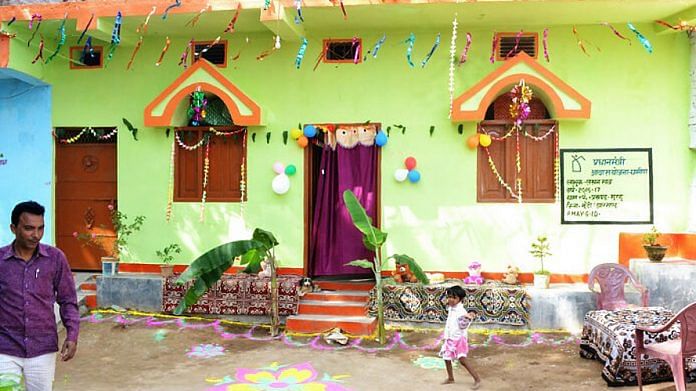New Delhi: Less than one-fourth of the landless beneficiaries have been provided plots to build homes under Prime Minister Narendra Modi’s pet rural housing scheme, the Pradhan Mantri Awaas Yojana (Grameen) or PMAY-G.
According to data for PMAY-G available with the rural development ministry, which oversees the scheme, so far only 21.9 per cent of the identified landless beneficiaries have been provided land. This was part of the discussion agenda during the scheme’s Performance Review Committee meeting held last week.
The ministry, however, clarified that the low figure referred to the “landless without homestead land” and is a factor of challenges owing to availability of public land, but “those who are landless in terms of agricultural land have been given houses in large numbers”.
“Those who have no agricultural land have been given land for houses under the scheme on a very large scale. The figures we are referring to pertain to those with no homestead land, and we are following up closely with states to overcome challenges like what land to allot,” said a senior official of the ministry who did not wish to be identified. “We will ensure their names do not get bumped off the permanent wait list.”
PMAY-G, which aims at housing for all, was a key priority for the first Modi government. While 1.5 crore houses were built between 2014 and 2019, the target is to complete 2 crore houses by 2022.
Also read: Modi govt’s 1,000-day rural target — 2 crore houses, roads to all villages, toilets in homes
The scheme
A centrally-sponsored Scheme, PMAY-G aims to “provide pucca houses with basic amenities to all house-less households and households living in kutcha and dilapidated houses in rural areas by 2022”.
To identify beneficiaries, it isn’t the traditional Below Poverty Line (BPL) list that is used but includes all those without houses as well as households living in zero, one or two-room houses with kutcha roof and wall as identified by the Socio-Economic Caste Census (SECC).
Although a revamped version of the Indira Awaas Yojana (IAY), this has been a marquee scheme of the Modi government, which pushed it aggressively and whose reach also gave the Bharatiya Janata Party (BJP) a fillip electorally.
What the data says
According to the data available with the ministry, only 92,287 of the identified 4,22,298 landless beneficiaries have been provided land for house construction.
The poor performers among states include Bihar where only 1.2 per cent of the identified landless beneficiaries have been provided land, Assam where the figure is 3.8 per cent, Himachal Pradesh is at 3 per cent, Odisha at 3.4 per cent, Kerala at 1.8 per cent and West Bengal at 3.7 per cent.
Some states, however, have managed to provide land to a majority of the landless. Uttar Pradesh, for instance, has managed to complete its target by giving PMAY-G land for houses to all identified landless, followed by Uttarakhand at 87 per cent, Madhya Pradesh at 86 per cent, Karnataka at 75 per cent, Chhattisgarh at 74 per cent, Gujarat at 62 per cent and Jharkhand at 51 per cent.
Also read: Modi cabinet approves extension of PM-KISAN scheme in its first meet






